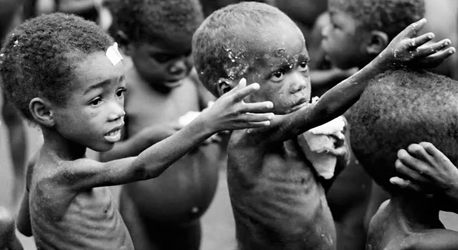
The Hunger in Africa
Africa is home to over 1.3 billion people. And hundreds of millions of them live in extreme poverty.
Twenty-seven of the world’s 28 poorest countries are in Sub-saharan Africa,1 where the population is growing faster than any place on Earth,2 and each has a poverty rate of over 30 percent.1
The poverty in Africa is made worse by population density, gender inequality, war, political instability, economic slowdowns and downturns, class conflict, corruption, natural disasters, and disease (e.g., AIDS, ebola, and COVID-19), and when coupled with drought and famine, the countries in Africa are regularly dealing with acute food shortages and food crises.
Of the 18 countries identified in 2020 as global hotspots for crisis by the World Food Programme, 13 are located in Africa. This likelihood of increased violence, unrest, and other threats, increases the already widespread food insecurity in these countries.
Food insecurity is defined as not having reliable access to a sufficient quantity of affordable, nutritious food that allows a person to remain healthy and lead an active life. Food insecurity affects about nine percent of the global population, with hundreds of millions of children experiencing hunger as a result.
One-fifth of the African population (256 million) are hungry, an increase of 44 million since 2014.3 Over the past 20 years, the prevalence of undernourishment has been highest in Eastern Africa and Central Africa because of issues with availability and access to food. However, since 2014, the prevalence of hunger has increased in Western and Central Africa, mostly as a result of armed conflicts, climate shocks, and economic forces.
Drought and Famine
Several regions of Africa have experienced severe lack of rainfall in recent decades, leading to famine and food shortages. Droughts have been especially concentrated in Eastern and Southern Africa.
Hunger in Ethiopia is now widespread after two years of drought, and according to USAID, 8.5 million Ethiopians are currently in need of food assistance.
Ethiopia has a history of drought in recent decades. So do many other east African countries, including South Sudan, Somalia, Djibouti, and Kenya.
These countries are full of nomadic tribes and remote villages, many of whom survive as sustenance farmers. When rains fail, food doesn’t grow, and the rural areas lack the infrastructure to help their people get access to food.
Even in instances where food may be available, either by traveling to another location or by transporting food into the area of food insecurity, many of the people can't afford the food because they earn less than a $1.90 a day, the definition of poverty.
Hunger rates are also at crisis levels in Southern Africa. According to the United Nations Office for the Coordination of Humanitarian Affairs, over 12 million people in Southern Africa were food insecure in 2019. But drought and famine are not the only cause of the hunger crisis in Africa.
Infectious Diseases
Infectious disease disproportionately affects the poor, especially hungry children. Hungry children are more susceptible to illness and infection, as chronic malnutrition damages a child’s immune system.
Without access to medical services or health care hungry children are often unable to get treatment, and even if treatment is available, it’s unlikely their families can afford it. This leads to treatable (and sometimes preventable) diseases becoming fatal.
Armed Conflict
Africa's many wars and frequent armed conflicts have damaged local food resources, as crops and fields get plundered, burned, and ravaged as part of the fighting. This fighting is the primary cause of refugees and Internally Displaced People (IDPs), people who are displaced within the borders of their own country.
Refugee and IDP camps where people seek safe shelter from the conflicts usually rely on the United Nations and other aid groups for food and health assistance. Without this help, adult and child malnutrition can quickly become an issue in the camps.
